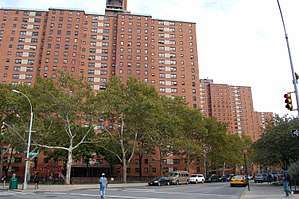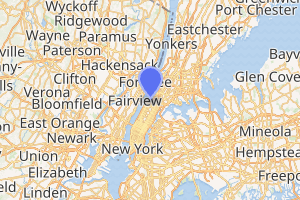Grant Houses
General Ulysses S. Grant Houses or Grant Houses is a public housing project at the northern boundary of Morningside Heights in the borough of Manhattan, New York City. The complex consists of 10 buildings with over 4,400 apartment units on 15.05-acres and is located between Broadway and Morningside Avenue, spanning oddly shaped superblocks from 123rd Street and La Salle Street to 125th Street. The development was named after Ulysses S. Grant (1822-1885), a Civil War Union army general and the 18th President of the United States.[3]
Grant Houses | |
|---|---|
 | |

Location in New York City | |
| Coordinates: 40.813830°N 73.957910°W | |
| Country | United States |
| State | New York |
| City | New York City |
| Borough | Manhattan |
| Area | |
| • Total | 0.023 sq mi (0.06 km2) |
| Population | |
| • Total | 4,477 [2] |
| ZIP codes | 10027 |
| Area code(s) | 212, 332, 646, and 917 |
| Website | my |
History
Morningside Heights Inc. (MHI) was founded by Columbia University and other area institutions to begin renovating Morningside Heights to target the "undesirables" and stop neighborhood blight in the neighborhood. David Rockefeller and Lawrence M. Orton, a planning commissioner, were President and Executive Director of the organization. MHI helped lobby for slum clearance in the 1940s with the intention of using the legislation to displace residents on the fringes of the neighborhood in order to keep the area middle-class. MHI then encouraged NYCHA to build the Grant Houses and Manhattanville Houses to the north of Morningside Gardens, a middle income cooperative. This created a buffer between Morningside Heights and Harlem. Prior to the construction of the Grant Houses, Columbia conducted a survey of residents on the site of which more than half said they were mostly satisfied with current housing, noting that overcrowding was lower in the area.[4]
Construction on the Grant Houses began in 1954[5] and was completed in 1956 at a cost of $29.2 million. 1,940 apartment units are contained within the apartment buildings in the Grant Houses. With eight of the buildings at 21 stories, they were the tallest housing projects in New York City when built. The buildings are managed by the New York City Housing Authority. For maximum sunlight exposure they lie directly north of Morningside Gardens. The redevelopment projects together aimed to retain the racially and economically mixed character of the Morningside-Manhattanville area before clearance. The New York Times noted the racial identification of the first five families to move into the Grant Houses: "two white, two Negro and one Puerto Rican."[6] President of City College, Buell G. Gallagher felt that the project would quickly become segregated, estimating 90% of residents to be African-American.[7]
By 1958 it was felt that the Grant Houses and other large developments in the neighborhood were doing little to improve the area. The development displaced roughly 7,000 residents who were mostly African-American or Puerto Rican and did little to improve older buildings nearby.[8][9]
In the early 1960s, crime began to rise and residents began organizing to obtain more police presence in the area.[10] In 2014, the Grant and Manhattanville Houses were the site of the largest gang bust in city history. 103 suspects were arrested on a 145-count indictment from a grand jury with crimes ranging from weapon possession to murder. Residents cited historic tensions between the developments and institutionalized racism as motivations behind the bust.[11][12]
Notable residents
- Ray Chew (born c. 1968), musical director of the Apollo Theater, lived there until age 7.[13]
- Chris Jackson, publisher[14]
- Pedro Pietri (1944–2004), writer and a co-founder of the Nuyorican Movement.[15]
- Keith Sweat (born 1961), R&B singer[16]
References
- "Grant Houses Area". Retrieved November 7, 2019.
- "Grant Houses Population".
- "MyNYCHA Developments Portal". my.nycha.info. Retrieved June 27, 2019.
- Chronopoulos, Themis (March 28, 2012). Spatial Regulation in New York City: From Urban Renewal to Zero Tolerance. Taylor & Francis. ISBN 9781136740688.
- "To Break Ground for Housing". New York Times. July 14, 1954. Retrieved June 27, 2019.
- Grutzner, Charles (August 20, 1956). "'Hello' to Gleam at Grant Houses; Community Welcome Slated for First Tenants in City's Tallest Public Housing Financing of Project". The New York Times. ISSN 0362-4331. Retrieved December 26, 2019.
- "HOUSING OFFICE SCORED; Gallagher Fears Segregated Pattern in Grant Houses". New York Times. October 3, 1957. Retrieved June 27, 2019.
- "MAYOR DEPLORES SLUM JOB DELAYS". New York Times. August 9, 1956. Retrieved June 27, 2019.
- "SLUMS ENGULFING COLUMBIA SECTION". New York Times. June 9, 1958. Retrieved June 27, 2019.
- Leadon, Fran (April 17, 2018). Broadway: A History of New York City in Thirteen Miles. W. W. Norton & Company. ISBN 9780393285451.
- Kramer, Abigail. "Busts, but not a solution, from NYPD tracking of housing feuds". Politico PRO. Retrieved June 27, 2019.
- "How Massive Gang Sweeps Make Growing Up In The Projects A Crime". Gothamist. October 24, 2016. Archived from the original on June 27, 2019. Retrieved June 27, 2019.
- Beckerman, Jim. "The pro who rules amateur night", The Record (Bergen County), June 28, 2009. Accessed June 28, 2009.
- Cunningham, Vinson (February 2, 2016). "How Chris Jackson Is Building a Black Literary Movement". The New York Times. ISSN 0362-4331. Retrieved June 27, 2019.
- Gonzalez, David (March 6, 2004). "Pedro Pietri, 59, Poet Who Chronicled Nuyorican Life". The New York Times. ISSN 0362-4331. Retrieved June 27, 2019.
- FEENEY, MICHAEL J. "Harlem-born R&B singer and radio host Keith Sweat releases new album". nydailynews.com. Retrieved June 27, 2019.